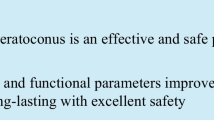Abstract
To evaluate the safety and efficacy of collagen cross-linking (CXL) in the treatment of keratoconus. A prospective randomized sham-controlled clinical trial was undertaken and 43 eyes with moderate to severe keratoconus were randomized into two groups that is the treatment (n = 23) and the sham (n = 20) group. CXL was performed with riboflavin (0.1 in 20 % dextran) followed by UVA radiation (365 nm, 3 mW/cm2, 30 min). In the sham group, only riboflavin was administered without UVA radiation. Uncorrected distance visual acuity (UDVA), corrected distance visual acuity, intraocular pressure, corneal thickness, keratometry, endothelial count, confocal microscopy were evaluated at baseline and at 1 week, 1, 3, and 6 months. In cases where CXL was done, UDVA improved by mean 0.11 ± 0.06 logMAR units at 6 months (P = 0.01). The refractive cylinder and spherical equivalent decreased by mean of 0.62 D (P = 0.01) and 0.5 D (P = 0.19), respectively. Ultrasonic central corneal thickness decreased by mean 22.7 ± 10.3 μm (P = 0.01). The maximum and minimum keratometry decreased by mean of 1.2 ± 0.8 D (P = 0.01) and 0.83 ± 1.2 D (P = 0.39), respectively. The specular count and intraocular pressure did not show any significant change. In the sham group, no significant change was observed in any parameter. Confocal analysis showed that the epithelial healing was complete at 1 week after crosslinking. The sub-epithelial plexus showed loss of nerve plexus at 1 month, regeneration of nerve fibers which started at 3 months and was complete at 6 months. The anterior stroma showed loss of keratocytes with honeycomb oedema and apoptotic bodies till 3 months. The regeneration of keratocytes started at 3 months and was complete at 6 months of follow-up. Collagen cross-linking is an effective procedure to halt progression in keratoconus. The confocal microscopic changes correlate with the outcomes in the treatment and the sham groups.


Similar content being viewed by others
References
Wollensak G, Spoerl E, Seiler T (2003) Riboflavin/ultraviolet-a-induced collagen crosslinking for the treatment of keratoconus. Am J Ophthalmol 135:620–627
Wollensak G, Spoerl E, Seiler T (2003) Stress-strain measurements of human and porcine corneas after riboflavin-ultraviolet-A-induced cross-linking. J Cataract Refract Surg 29:1780–1785
Daxer A, Misof K, Grabner B et al (1998) Collagen fibrils in the human corneal stroma: structure and aging. Investig Ophthalmol Vis Sci 39:644–648
Wittig-Silva C, Whiting M, Lamoureux E et al (2008) A randomized controlled trial of corneal collagen cross-linking in progressive keratoconus: preliminary results. J Refract Surg 24:S720–S725
Hersh PS, Greenstein SA, Fry KL (2011) Corneal collagen crosslinking for keratoconus and corneal ectasia: one-year results. J Cataract Refract Surg 37:149–160
Lamy R, Netto CF, Reis RG et al. (2013) Effects of corneal cross-linking on contrast sensitivity, visual acuity, and corneal topography in patients with keratoconus. Cornea 32:591–596
Vinciguerra P, Albè E, Trazza S et al (2009) Refractive, topographic, tomographic, and aberrometric analysis of keratoconic eyes undergoing corneal cross-linking. Ophthalmology 116:369–378
Greenstein SA, Shah VP, Fry KL et al (2011) Corneal thickness changes after corneal collagen crosslinking for keratoconus and corneal ectasia: one-year results. J Cataract Refract Surg 37:691–700
Kymionis GD, Portaliou DM, Bouzoukis DI et al (2007) Herpetic keratitis with iritis after corneal crosslinking with riboflavin and ultraviolet A for keratoconus. J Cataract Refract Surg 33:1982–1984
Rama P, Di Matteo F, Matuska S et al (2009) Acanthamoeba keratitis with perforation after corneal crosslinking and bandage contact lens use. J Cataract Refract Surg 35:788–791
Sharma N, Maharana P, Singh G et al (2010) Pseudomonas keratitis after collagen crosslinking for keratoconus: case report and review of literature. J Cataract Refract Surg 36:517–520
Pérez-Santonja JJ, Artola A, Javaloy J et al (2009) Microbial keratitis after corneal collagen crosslinking. J Cataract Refract Surg 35:1138–1140
Mazzotta C, Traversi C, Baiocchi S et al (2008) Corneal healing after riboflavin ultraviolet-A collagen cross-linking determined by confocal laser scanning microscopy in vivo: early and late modifications. Am J Ophthalmol 146:527–533
Kymionis GD, Diakonis VF, Kalyvianaki M et al (2009) One-year follow-up of corneal confocal microscopy after corneal cross-linking in patients with post laser in situ keratosmileusis ectasia and keratoconus. Am J Ophthalmol 147:774–778
Caporossi A, Baiocchi S, Mazzotta C et al (2006) Parasurgical therapy for keratoconus by riboflavin-ultraviolet type A rays induced cross-linking of corneal collagen: preliminary refractive results in an Italian study. J Cataract Refract Surg 32:837–845
Raiskup-Wolf F, Hoyer A, Spoerl E et al (2008) Collagen crosslinking with riboflavin and ultraviolet-A light in keratoconus: long-term results. J Cataract Refract Surg 34:796–801
O’Brart DPS, Kwong TQ, Patel P et al (2013) Long-term follow-up of riboflavin/ultraviolet A (370 nm) corneal collagen cross-linking to halt the progression of keratoconus. Br J Ophthalmol 97:433–437
Caporossi A, Mazzotta C, Baiocchi S et al (2010) Long-term results of riboflavin ultraviolet a corneal collagen cross-linking for keratoconus in Italy: the Siena eye cross study. Am J Ophthalmol 149:585–593
Conflict of interest
No conflicting relationship exists for any author.
Author information
Authors and Affiliations
Corresponding author
Rights and permissions
About this article
Cite this article
Sharma, N., Suri, K., Sehra, S.V. et al. Collagen cross-linking in keratoconus in Asian eyes: visual, refractive and confocal microscopy outcomes in a prospective randomized controlled trial. Int Ophthalmol 35, 827–832 (2015). https://doi.org/10.1007/s10792-015-0054-x
Received:
Accepted:
Published:
Issue Date:
DOI: https://doi.org/10.1007/s10792-015-0054-x




